Introduction and Initial Thoughts
This task was completed on Thursday July 21st, 2022, my reflections were completed the next day. I chose to do this as I had an eventful day in terms of leaving the house and actually going to an appointment. Most days during my summer vacation are spent at home, reading, watching television, talking to friends and completing school related assignments. As I was looking back on my day, I did find it quite difficult to think about my attention and its patterns when it comes to what areas I was focusing on. I did however find it easier to actually reflect on what I was focusing my attention on and whether or not that attention was focused or not (i.e., was I multitasking or not?). I made a conscious effort to stop after each focused activity to reflect on my attention. This would not have been possible if I was working as working as an elementary school teacher barely gives me time to take my full lunch break let alone stop and think about what I was focusing on. With the use of charts and records I will give an overview of the things that my attention was spent on for 12 hours.
Many times, throughout the day I would sometimes forget for a short period of time to sit back and reflect on my attention and thoughts each hour. Citton states that, “Paying attention is a genuine activity – preceding any form of subsequent action: it implies weaving together observations and gestures while respecting the correct level of tension for maintaining tenable relations with our milieu” (Citton, 2017, p. 23). After a couple of hours of struggling to remember and genuinely thinking about where my attention lied, I utilized the alarm application on my phone to specifically remind me for the rest of the day to stop and check in. I kept a log in my notebook of the timeline of the day and my thoughts and then digitized them afterwards. In the beginning of the assignment, I found it quite tedious to actually think about what I was thinking about and what I was paying attention to, especially when it came to driving. Both times when I drove to Starbucks and when I drove to the dog groomer my mind was occupied. When I drove to Starbucks, I typically listen to music and enjoy the drive whereas when I am driving with my dog in the car, I am typically extremely anxious, worried about him and where he is in the car (he does not like being in the back-seat), and worried about staying safe on the road. It is harder to pin-point what I was focusing on and giving my attention to and that point as all I really wanted to do was get from my home to the groomers safely. What was also interesting to note is that much of my time was spent focusing on this assignment and my attention was centred around when and where should I stop to take notes and record for this assignment. In the article by de Castell and Jenson, they state that each and every one of us, “owns and controls a full economic share of her or his own attention” but this assignment did have a large amount of control over my attention which would not be the case for a regular day (2004, p.381).
My Day and Thoughts on My Attentional Energy
I will first take time to go over the data that I collected and also how I viewed the information in thinking about where my attention has focused on throughout the day. Most of my days, on summer break from teaching, are spent interacting with my dog and my family but on this particular weekday, no one was home for the majority of the day as they were at work outside of the home. My morning wake-up time is structured based on when my dog eats breakfast and so my alarm (on my phone) is pre-set to reflect that time. The first thing I always do when I wake up is take my dog outside and my attention is focused on making sure he is able to relieve himself and feed him the correct amount of food that is measured by his measuring spoons. While my dog eats and spends time outside, I check into Twitter and Instagram to get “caught up” on any news or entertainment I missed during my sleep time. I also check emails and text messages that I try to respond to as well. A lot of my day is centred around my dog and ensuring his health and well-being but during the summer months, I am also able to focus my attention to myself and on my own self-care and driving to get a coffee is part of that routine. When I think about the things that take the most attention from me, it would be:
• Myself and My needs
• My Dog and His needs
• Technology
• Inside/Home Environment
• Outside/ Outside of Home Environment
My Attentional Records Pie Chart refers to the percentage of how many times these above-mentioned categories took up my attention.
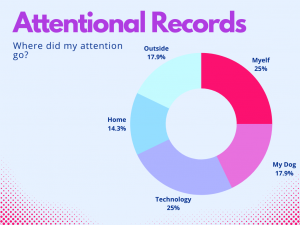
As a natural process, I was also able to record my feelings and emotions throughout the day, especially during the point of an attention-grabbing moment. My Emotions Chart shows the percentages of each given emotion throughout the 12-hour timespan. In thinking about these feelings, I have noticed that a good part of my day, especially when being outside the home and interacting with others, leads to sometimes feeling annoyed or frustrated but also often times happy. On this particular day there were minimal feelings of sadness, except those brought on by watching a dramatic television show.
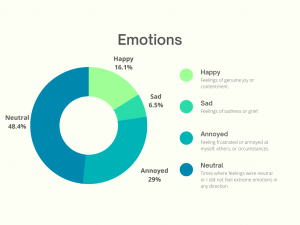
Analysis of My Results and Thoughts on Attention and Education
During my day of reflection, the day after recording where my attention lay, I had some insights regarding attention and how attention is allocated, particularly in schools, and particularly with students in a classroom. De Castell and Jenson state that, “Today, attention in schools is altered by political and technological conditions that have disrupted the traditional distribution of ‘‘information,’’ and thereby knowledge, where — at least in schools — the role of the teacher has been central” (2004, p. 382). It had not occurred to me previously to think about how often myself, as the educator, is the centre of attention for many of my students for a significant portion of the day. Although my personal teaching style does not highlight me being in the front of the classroom and lecturing for extended periods of time, my presence as the “leader” of the classroom has that effect on attention. Students may be thinking about my expectations for an assignment or to hear from me to answer their questions. In a traditional classroom with formal lectures and lessons, the teacher is even more the focus and commanding presence in a room that elicits attention.
Another place where education and attention intersect is when it comes to technology, “teachers grapple with ways to attract, rather than compel, students ‘voluntary attention” because “new technologies afford them far greater power and greatly expanded rights” (De Castell & Jenson, 2004, p. 380). As someone who teaches pre-teens in grade 6/7, I have first-hand experience in thinking about how to incorporate technology into my educational practice as I know that technological devices, application, and games, have a significant influence in this age cohort’s life. As educators, we find ways to make sure that students are engaged in the lessons we are having to teach and one way to do that is by utilizing these technologies to keep attention spans going. Some personal examples in my own classroom include having students listen to podcasts about evolution for our science unit and then creating their own podcasts at the end of the unit as well as also incorporating students love of Minecraft into building our own ancient civilization. Citton states that an attention economy is essentially, “a family of senders, which employ costly signals to attract the attention of audiences and have an impact on them” (2017, p. 7). With this thought in mind, teachers are effectively the senders who imply signals, or new and innovative teaching methods to keep students engaged and impact their ways of learning.
Conclusion
In essence, attention is the goal of which all educators, and really humans, are trying to achieve. Citton states that “managing attention and attracting attention are becoming universal maxims in business and economics” (2017, p. 7). Many can argue that this is the case in all facets of the world, including education. Whether we are just brushing our teeth, trying to perfect a recipe for dinner or thinking of new ways to keep students engaged in their learning, we are employing various forms of attention. Attention is a foundational part of our human experience and effects our everyday lives (work, family, school, and beyond) whether we reflect about it or not. Ultimately, we should take the time to understand where our attention is going to and how those areas can impact how we view the world and how we view ourselves.
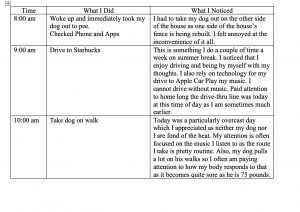
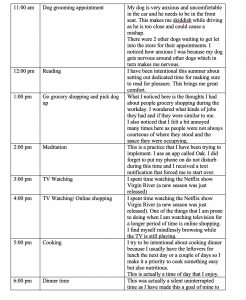
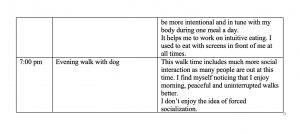
References
Citton, Y. (2017). Introduction and Conclusion : From Attention Economy to Attention Ecology. In The Ecology of Attention. John Wiley & Sons.
de Castell, S. & Jenson, J. (2004). Paying Attention to Attention: New Economies for Learning (Links to an external site.)” Educational Theory, 54 (4): 381 – 397.

